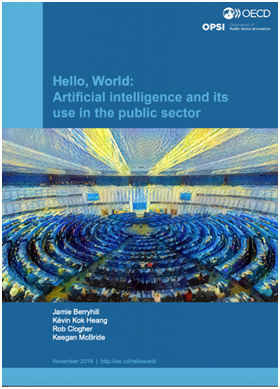The OECD’s Observatory of Public Sector Innovation (OPSI) has launched the primer Hello, World: Artificial Intelligence and its Use in the Public Sector. This primer is intended to help pubic officials take their first steps in exploring Artificial Intelligence (AI).
The primer is the result of 10 months of research and analysis focused specifically on the use and implications of AI in government. t has benefited from the input of dozens of experts and stakeholders, including through a seven-week public consultation, which received about 1,500 comments from over 75 individuals or organisations, including governments, academics, AI experts, businesses, and civil society organisations.
The AI primer is broken up into four chapters that seek to achieve three key aims:
- Background & Technical Explainer.
- Public Sector Landscape -AI Strategies.
- Government Implications and Guidance.

Background & Technical Explainer
These aspects of the primer can assist government leaders and public servants in many ways. For example, understanding some of the technical underpinnings can help officials decide which of these tools can best be applied to address specific problems, and become more empowered in negotiations with vendors seeking to sell AI or more traditional solutions.
Public Sector Landscape -AI Strategies
This section discusses each country’s complete or forthcoming national AI strategy. This includes a focus on the extent to which each specifically addresses public sector innovation and transformation. The mapping has identified 50 countries (including the European Union) that have launched, or have plans to launch, national AI strategies. Of these 50 countries, 36 have (or plan to have) either separate strategies in place for public sector AI, or a dedicated focus embedded within a broader strategy.
Government Implications and Guidance
In order to help governments learn about and explore AI in an effective and ethical way, the AI primer includes guidance on: providing support and clear direction and create space for flexibility and experimentation, determine whether AI is the best solution for a given problem, developing a trustworthy, fair, and accountable approach to using AI, among others.
Finally, the primer includes case studies and real-world examples of efforts, projects, and other AI initiatives that are already occurring.
You can download and read the AI primer here.
